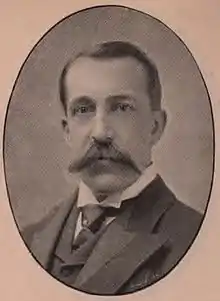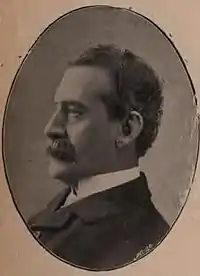| Howdenshire | |
|---|---|
| Former County constituency for the House of Commons | |
| County | East Riding of Yorkshire |
| 1885–1950 | |
| Created from | East Riding of Yorkshire |
| Replaced by | Beverley and Kingston upon Hull Haltemprice |
Howdenshire was a county constituency in Yorkshire which returned one Member of Parliament (MP) to the House of Commons of the Parliament of the United Kingdom, elected by the first past the post voting system.
It was created for the 1885 general election, and abolished for the 1950 general election.
Boundaries
1885–1918: The Sessional Divisions of Holme Beacon, Howdenshire, South Hunsley Beacon, Wilton Beacon, and Ouse and Derwent (except the part included in the extended Municipal Borough of York).
1918–1950: The Urban Districts of Hessle and Pocklington, the Rural Districts of Escrick, Howden, Pocklington, and Riccall, in the Rural District of Beverley the civil parishes of Brantingham, Ellerker, Elloughton with Brough, and South Cave, and part of the Rural District of Sculcoates.
Members of Parliament
Election results
Elections in the 1880s
| Party | Candidate | Votes | % | ±% | |
|---|---|---|---|---|---|
| Conservative | Arthur Duncombe | 4,525 | 57.6 | ||
| Liberal | Anthony George Shiell | 3,334 | 42.4 | ||
| Majority | 1,191 | 15.2 | |||
| Turnout | 7,859 | 82.7 | |||
| Registered electors | 9,502 | ||||
| Conservative win (new seat) | |||||
| Party | Candidate | Votes | % | ±% | |
|---|---|---|---|---|---|
| Conservative | Arthur Duncombe | Unopposed | |||
| Conservative hold | |||||
Elections in the 1890s

| Party | Candidate | Votes | % | ±% | |
|---|---|---|---|---|---|
| Conservative | William Wilson-Todd | 3,998 | 52.3 | N/A | |
| Liberal | James Woodhouse | 3,648 | 47.7 | New | |
| Majority | 350 | 4.6 | N/A | ||
| Turnout | 7,646 | 80.5 | N/A | ||
| Registered electors | 9,499 | ||||
| Conservative hold | Swing | N/A | |||

| Party | Candidate | Votes | % | ±% | |
|---|---|---|---|---|---|
| Conservative | William Wilson-Todd | Unopposed | |||
| Conservative hold | |||||
Elections in the 1900s
| Party | Candidate | Votes | % | ±% | |
|---|---|---|---|---|---|
| Conservative | William Wilson-Todd | Unopposed | |||
| Conservative hold | |||||
| Party | Candidate | Votes | % | ±% | |
|---|---|---|---|---|---|
| Conservative | Henry Harrison-Broadley | 4,763 | 53.4 | N/A | |
| Liberal | Percy George Reginald Benson | 4,150 | 46.6 | New | |
| Majority | 613 | 6.8 | N/A | ||
| Turnout | 8,913 | 90.1 | N/A | ||
| Registered electors | 9,893 | ||||
| Conservative hold | Swing | N/A | |||
Elections in the 1910s
| Party | Candidate | Votes | % | ±% | |
|---|---|---|---|---|---|
| Conservative | Henry Harrison-Broadley | 5,423 | 56.4 | +3.0 | |
| Liberal | Francis Benedict Vincent Norris | 4,186 | 43.6 | −3.0 | |
| Majority | 1,237 | 12.8 | +6.0 | ||
| Turnout | 9,609 | 90.7 | +0.6 | ||
| Registered electors | 10,597 | ||||
| Conservative hold | Swing | +3.0 | |||
| Party | Candidate | Votes | % | ±% | |
|---|---|---|---|---|---|
| Conservative | Henry Harrison-Broadley | 5,016 | 56.4 | 0.0 | |
| Liberal | Francis Benedict Vincent Norris | 3,885 | 43.6 | 0.0 | |
| Majority | 1,131 | 12.8 | 0.0 | ||
| Turnout | 8,901 | 84.0 | −6.7 | ||
| Registered electors | 10,597 | ||||
| Conservative hold | Swing | 0.0 | |||
General Election 1914–15:
Another General Election was required to take place before the end of 1915. The political parties had been making preparations for an election to take place and by the July 1914, the following candidates had been selected;
- Unionist: Henry Harrison-Broadley
- Liberal: Thomas Fenby
| Party | Candidate | Votes | % | ±% | |
|---|---|---|---|---|---|
| Unionist | Stanley Jackson | Unopposed | |||
| Unionist hold | |||||

| Party | Candidate | Votes | % | ±% | |
|---|---|---|---|---|---|
| C | Unionist | Stanley Jackson | 9,023 | 67.3 | +10.9 |
| Liberal | Thomas Fenby | 4,384 | 32.7 | −10.9 | |
| Majority | 4,639 | 34.6 | +21.8 | ||
| Turnout | 13,407 | 57.1 | −26.9 | ||
| Registered electors | 23,481 | ||||
| Unionist hold | Swing | +10.9 | |||
| C indicates candidate endorsed by the coalition government. | |||||
Elections in the 1920s
| Party | Candidate | Votes | % | ±% | |
|---|---|---|---|---|---|
| Unionist | Stanley Jackson | 10,748 | 60.5 | −6.8 | |
| National Farmers' Union | Herbert John Winn | 7,021 | 39.5 | New | |
| Majority | 3,727 | 21.0 | −13.6 | ||
| Turnout | 17,769 | 71.1 | +14.0 | ||
| Registered electors | 24,975 | ||||
| Unionist hold | Swing | N/A | |||
| Party | Candidate | Votes | % | ±% | |
|---|---|---|---|---|---|
| Unionist | Stanley Jackson | Unopposed | |||
| Unionist hold | |||||
| Party | Candidate | Votes | % | ±% | |
|---|---|---|---|---|---|
| Unionist | Stanley Jackson | Unopposed | |||
| Unionist hold | |||||
| Party | Candidate | Votes | % | ±% | |
|---|---|---|---|---|---|
| Unionist | William Carver | 10,653 | 54.2 | N/A | |
| Liberal | Frederick Linfield | 6,668 | 34.0 | New | |
| Labour | John William Kneeshaw | 2,318 | 11.8 | New | |
| Majority | 3,985 | 20.2 | N/A | ||
| Turnout | 19,639 | 73.6 | N/A | ||
| Registered electors | 26,682 | ||||
| Unionist hold | Swing | N/A | |||
| Party | Candidate | Votes | % | ±% | |
|---|---|---|---|---|---|
| Unionist | William Carver | 13,823 | 51.2 | N/A | |
| Liberal | Edward Baker | 13,170 | 48.8 | N/A | |
| Majority | 653 | 2.4 | N/A | ||
| Turnout | 26,993 | 76.8 | N/A | ||
| Registered electors | 35,164 | ||||
| Unionist hold | Swing | N/A | |||
Elections in the 1930s
| Party | Candidate | Votes | % | ±% | |
|---|---|---|---|---|---|
| Conservative | William Carver | Unopposed | N/A | N/A | |
| Conservative hold | Swing | N/A | |||
| Party | Candidate | Votes | % | ±% | |
|---|---|---|---|---|---|
| Conservative | William Carver | 18,155 | 63.9 | N/A | |
| Liberal | Edward Baker | 7,837 | 27.5 | New | |
| Labour | James Richardson | 2,459 | 8.6 | New | |
| Majority | 10,318 | 36.4 | N/A | ||
| Turnout | 28,451 | 69.2 | N/A | ||
| Conservative hold | Swing | ||||
Elections in the 1940s
General Election 1939–40: Another General Election was required to take place before the end of 1940. The political parties had been making preparations for an election to take place from 1939 and by the end of this year, the following candidates had been selected;
- Conservative: Clifford Glossop
| Party | Candidate | Votes | % | ±% | |
|---|---|---|---|---|---|
| Conservative | Clifford Glossop | 21,348 | 55.9 | -8.0 | |
| Labour Co-op | Thomas Neville | 11,161 | 29.2 | +20.6 | |
| Liberal | John Edward Wilson | 5,669 | 14.9 | -12.6 | |
| Majority | 10,187 | 26.7 | -9.7 | ||
| Turnout | 38,178 | 71.3 | +2.1 | ||
| Conservative hold | Swing | ||||
| Party | Candidate | Votes | % | ±% | |
|---|---|---|---|---|---|
| Conservative | George Odey | 23,344 | 64.0 | +8.1 | |
| Labour Co-op | Thomas Neville | 9,298 | 25.5 | -3.7 | |
| Liberal | John Edward Wilson | 3,819 | 10.5 | -4.4 | |
| Majority | 14,046 | 38.5 | +11.8 | ||
| Turnout | 36,461 | ||||
| Conservative hold | Swing | ||||
References
- 1 2 3 4 5 6 The Liberal Year Book, 1907
- ↑ Debrett's House of Commons & Judicial Bench, 1886
- 1 2 3 4 5 6 7 8 9 Craig, FWS, ed. (1974). British Parliamentary Election Results: 1885-1918. London: Macmillan Press. ISBN 9781349022984.
- 1 2 Debrett's House of Commons & Judicial Bench, 1901
- 1 2 3 Debrett's House of Commons & Judicial Bench, 1916
- 1 2 3 4 5 6 7 8 Craig, F. W. S. (1983). British parliamentary election results 1918-1949 (3 ed.). Chichester: Parliamentary Research Services. ISBN 0-900178-06-X.
- ↑ UK General Election results: July 1945
- ↑ 1947 By Elections